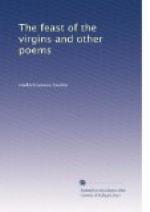PREFACE
At odd hours during an active and busy life I have dallied with the Muses. I found in them, in earlier years, rest from toil and drudgery and, later, relief from physical suffering.
Broken by over-work and compelled to abandon the practice of my profession—the law, I wrote Pauline after I had been given up to die by my physicians. It proved to be a better ‘medicine’ for me than all the quackeries of the quacks. It diverted my mind from myself and, perhaps, saved my life. When published, its reception by the best journals of this country and England was so flattering and, at the same time, the criticisms of some were so just, that I have been induced to carefully revise the poem and to publish my re-touched Pauline in this volume. I hope and believe I have greatly improved it. Several of the minor poems have been published heretofore in journals and magazines; others of equal or greater age flap their wings herein for the first time; a few peeped from the shell but yesterday.
I am aware that this volume contains several poems that a certain class of critics will condemn, but they are my “chicks” and I will gather them under my wings.
“None but an author knows an author’s cares, Or Fancy’s fondness for the child she bears.”—Cowper.
Much of my life has been spent in the Northwest—on the frontier of civilization, and I became personally acquainted with many of the chiefs and braves of the Dakota and Ojibway (Chippewa) Indians. I have written of them largely from my own personal knowledge, and endeavored, above all things, to be accurate, and to present them true to the life.
For several years I devoted my leisure hours to the study of the language, history, traditions, customs and superstitions of the Dakotas. These Indians are now commonly called the “Sioux”—a name given them by the early French traders and voyageurs. “Dakota” signifies alliance or confederation. Many separate bands, all having a common origin and speaking a common tongue, were united under this name. See “Tah-Koo Wah-Kan,” or “The Gospel Among the Dakotas,” by Stephen R. Riggs, pp. 1 to 6 inc.
They were but yesterday the occupants and owners of the fair forests and fertile prairies of Minnesota—a brave, hospitable and generous people—barbarians, indeed, but noble in their barbarism. They may be fitly called the Iroquois of the West. In form and features, in language and traditions, they are distinct from all other Indian tribes. When first visited by white men, and for many years afterwards, the Falls of St. Anthony (by them called the Ha Ha) was the center of their country. They cultivated corn and tobacco, and hunted the elk, the beaver and the bison. They were open-hearted, truthful and brave. In their wars with other tribes they seldom slew women or children, and rarely sacrificed the lives of their prisoners.




